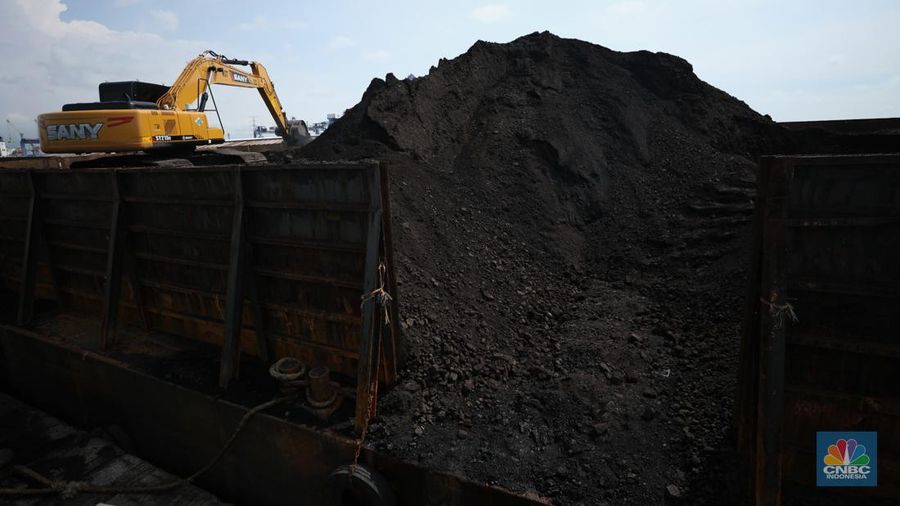
Jakarta, CNBC Indonesia- Coal prices for the September contract are still burning. Black sand prices even continued to strengthen for 12 consecutive trading days, the most since 13 years ago or December 2009.
Coal prices also broke through the psychological level of US$160 again, or the highest since May 5, 2023.
The skyrocketing prices occur in line with global demand, especially Asia, which is expected to exceed the previous record. In addition, the drought in the Panama Canal has disrupted US coal shipping routes to global markets.
China’s high imports from Australia are the highest in three years, the possibility of Indian demand improving again, and the potential for a strike by the liquefied natural gas (LNG) union in Australia have also contributed to strengthening coal prices.
Referring to Refinitiv, the ICE Newcastle coal price for the September contract closed at US$ 164.75 per ton, up 1.7% in trading Tuesday (22/8/2023). This price is the highest since May 5, 2023 or in the last three months.
Yesterday’s strengthening was an extraordinary record because it was a record in itself. Yesterday’s strengthening extended the record increase in coal prices for 12 consecutive days.
This record was last created at the end of December 2009 or the last 13 years. Even when coal soared extraordinarily in 2022, coal prices were unable to score gains for 12 days. The previous longest reinforcement lasted ten straight days.
The surge in coal prices was triggered by high demand. According to the International Energy Agency (IEA) global coal production, consumption and volumes are all at all-time highs in 2023.
Even though western countries such as the United States (US) and Europe are starting to show an economic slowdown, Asian countries, especially China, are actually recording higher demand for coal, so there will be potential for prices to strengthen.
This was an opportunity for the US to increase its shipments to China, but the drought in Panama caused delays and rerouting of shipments which impacted freight rates.
BRS reported earlier this month that “coaled ships out of the Atlantic are deviating from their preferred Panama Canal route due to increased transit times. Any change to the fronthaul trade route will increase sailing days from approximately 35 days via the Panama Canal to 50 days via the Suez Canal to coal loaded at the US port of Burnside [Louisiana] for disposal in Rizhao, China.”
Seaborne coal volumes are expected to reach 1,335,000 million metric tonnes this year, surpassing the 2019 record of 1,331,000 tonnes, the IEA said in its newly released mid-year outlook.
The IEA also estimates that global coal demand will be 8.39 million tonnes higher this year, compared to last year’s all-time high.
For information, 3 out of 4 of the world’s coal will be consumed by China, India and Southeast Asia. China’s own contribution reaches 56% of global consumption.
Focusing on China, China’s coal imports from Australia increased in July. This is because Australian high-quality coal (5,500 kilocalories) is still up to 70 yuan (US$9.62) per ton cheaper than China’s domestic price. The high demand comes from the need for power plants to remain strong amid the biting hot weather.
Data from China’s General Administration of Customs released on Sunday showed that China imported 6.31 million metric tonnes of Australian coal last month, up from 4.83 million tonnes in June, and a three-year high.
High-quality Australian thermal coal is urgently needed for China’s power plants to meet soaring electricity consumption during the summer, when households increase demand for air conditioning.
Analysts and market participants expect China’s coal imports from Australia to remain high throughout the year, supported by large import gains and lower production due to stricter mine safety inspections.
Customs data also shows that China imported 15.83 million tonnes of coal from Indonesia in July, of which the majority had relatively lower calories than Australia.
Turning to the Indian market, demand is again visible. Launch India TV News, India’s Minister of Electricity RK Singh will hold a meeting today, Tuesday (22/8/2023) to review the availability of coal for thermal power plants.
India’s Ministry of Coal said that currently available 77 million tonnes of dry fuel is more than sufficient to meet the needs of the power sector.
Various sources inform that the fuel supply can meet the 40 days of India’s monsoons. According to estimates, intensive use will leave as much as 1.5 million tonnes of coal.
However, without significant additional production, India will need to import again to meet demand. This will reduce global supply. Increasing demand for India as the second largest consumer will have a significant effect on pushing coal prices higher.
From Europe, the region whose main energy source is gas is showing concern due to the potential for a strike by the LNG workers union from Australia.
The latest news is that unions in the oil and gas sector are taking dramatic steps in response to dissatisfaction with pay levels and working conditions.
On Sunday (20/8/2023), one of the workers’ alliances of Australia’s largest LNG producer, Woodside Energy Group, announced their decision to strike offshore gas unions in the North West.
Meanwhile, the Chevron group is also facing a similar situation and is holding a vote on a potential strike at the Wheatstone and Gorgon LNG facilities, with results scheduled to be announced on Thursday (24/8/2023).
The strike announced by Woodside is set to begin on September 2, 2023, with union Chevron expected to follow in the footsteps of its Woodside counterparts.
The implementation of the strike is scheduled to take place seven days after the decision is made. This situation has the potential to create disruptions in the global energy supply. This is because the three LNG refineries in Western Australia contribute around 10% of the world’s total supply.
Gas supply disruptions will also contribute to the increase in coal, because this will encourage speculation on substitute energy sources. European natural gas prices EU Dutch TTF (EUR) broke the psychological level of EUR 40 per MWh. Prices shot up 5.22% to 42.91 euros per mega-watt hour (MWh).




